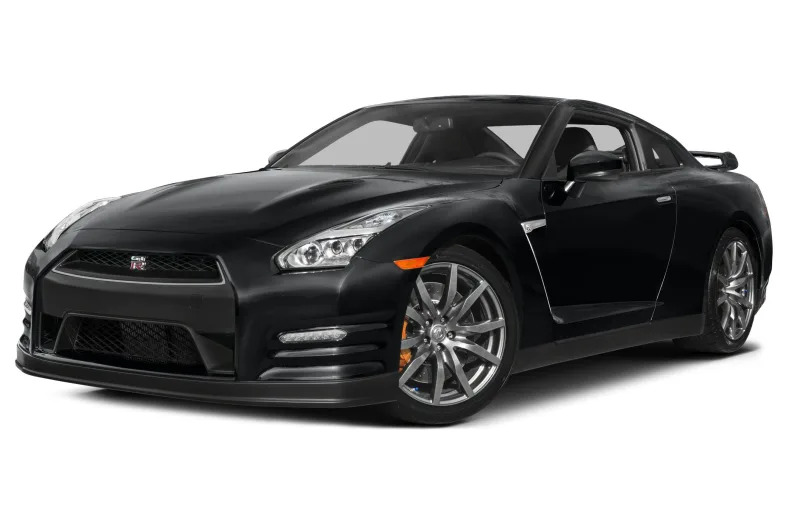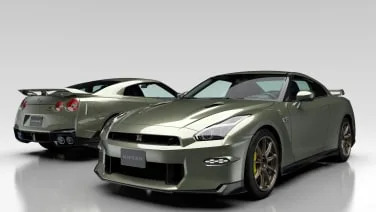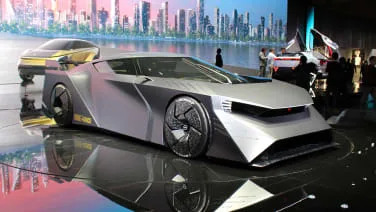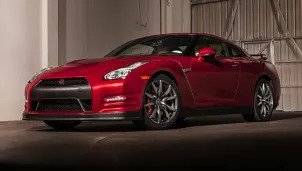Premium 2dr All-Wheel Drive Coupe
2015 Nissan GT-R
Although the first Skyline GT-R from Nissan arrived in 1969, in the 46 years since, there have nearly been as many years without a GT-R as with. The first two generations were produced from 1969 to 1972, the next three generations stretched from 1989 to 2002, and the most recent (just plain GT-R in fact, not a Skyline GT-R) has so far run from 2009 to 2015. That's 25 years that the GT-R has been a member of the material world, and 21 that it has lived in purgatorio. Yet out of those 46 years, the birth of the legend and cult of the GT-R happened primarily in five: from 1989 to 1994, when a chassis codenamed BNR32 – just plain R32 to its friends and enemies – with a 2.6-liter straight-six engine, stuck a defibrillator on the corpus motorsportus and ran a 600-horsepower, four-wheel-drive, four-wheel-steered blast of "Take that!" through the heart of Group A racing. Sure, the KPGC10 and KPGC110 won 49 consecutive races in Japan from 1968 to 1972. Sure, the R33 (1995 – 1998) ran the winning streak of the R32 out to 50 victories in 50 races in Japan's N1 Super Taikyu series, and was the first production car to break the eight-minute mark at the Nürburgring. Sure, the R34 (1999 – 2002) was still a championship-winning car as well as the handsome, square-jawed evolution that you could finally take home to mom's crazy sister and your Playstation-addicted brother. But it was the R32 that won its first 29 races in Japan and took the Group A championship four years in a row. It was the R32 that earned the nickname "Godzilla" in Australia by winning the 1,000-kilometer race at Bathurst two years in a row and the Australian Touring Car Championship three years in a row before the regulations were changed to excise it from competition. It was the R32 that won its class in the 24 Hours of Spa three years in a row. It was the R32 that spawned the production Skyline GT-R, the 276-horsepower Pegasus that bestowed race-ready ATTESA-ETS 4WD (Advanced Total Traction Engineering System for All – Electronic Torque Split) and Super-HICAS (High Capacity Actively Controlled Suspension) four-wheel steering upon the common man. And it was the R32 that did all this at half the price of a Porsche, and in just four markets: Japan, Hong Kong, Australia and New Zealand. It wasn't until 1997 that the R33 would begin to be imported to the UK. The day after obsessively covering the Tokyo Motor Show we were given the briefest of chances to drive the new R35 GT-R and GT-R Nismo, super-coupes whose umbilici are plugged into the R32. More proof? It was the R32 that birthed the first Skyline GT-R Nismo edition, a road-legal homologation special with aero mods and one color choice: Gunmetal Grey. Nissan said this new GT-R is more mature, and after our drive we're prepared to admit that's the case, as long as we …
Full Review
Although the first Skyline GT-R from Nissan arrived in 1969, in the 46 years since, there have nearly been as many years without a GT-R as with. The first two generations were produced from 1969 to 1972, the next three generations stretched from 1989 to 2002, and the most recent (just plain GT-R in fact, not a Skyline GT-R) has so far run from 2009 to 2015. That's 25 years that the GT-R has been a member of the material world, and 21 that it has lived in purgatorio. Yet out of those 46 years, the birth of the legend and cult of the GT-R happened primarily in five: from 1989 to 1994, when a chassis codenamed BNR32 – just plain R32 to its friends and enemies – with a 2.6-liter straight-six engine, stuck a defibrillator on the corpus motorsportus and ran a 600-horsepower, four-wheel-drive, four-wheel-steered blast of "Take that!" through the heart of Group A racing. Sure, the KPGC10 and KPGC110 won 49 consecutive races in Japan from 1968 to 1972. Sure, the R33 (1995 – 1998) ran the winning streak of the R32 out to 50 victories in 50 races in Japan's N1 Super Taikyu series, and was the first production car to break the eight-minute mark at the Nürburgring. Sure, the R34 (1999 – 2002) was still a championship-winning car as well as the handsome, square-jawed evolution that you could finally take home to mom's crazy sister and your Playstation-addicted brother. But it was the R32 that won its first 29 races in Japan and took the Group A championship four years in a row. It was the R32 that earned the nickname "Godzilla" in Australia by winning the 1,000-kilometer race at Bathurst two years in a row and the Australian Touring Car Championship three years in a row before the regulations were changed to excise it from competition. It was the R32 that won its class in the 24 Hours of Spa three years in a row. It was the R32 that spawned the production Skyline GT-R, the 276-horsepower Pegasus that bestowed race-ready ATTESA-ETS 4WD (Advanced Total Traction Engineering System for All – Electronic Torque Split) and Super-HICAS (High Capacity Actively Controlled Suspension) four-wheel steering upon the common man. And it was the R32 that did all this at half the price of a Porsche, and in just four markets: Japan, Hong Kong, Australia and New Zealand. It wasn't until 1997 that the R33 would begin to be imported to the UK. The day after obsessively covering the Tokyo Motor Show we were given the briefest of chances to drive the new R35 GT-R and GT-R Nismo, super-coupes whose umbilici are plugged into the R32. More proof? It was the R32 that birthed the first Skyline GT-R Nismo edition, a road-legal homologation special with aero mods and one color choice: Gunmetal Grey. Nissan said this new GT-R is more mature, and after our drive we're prepared to admit that's the case, as long as we …
Hide Full Review
Hide Full Review
Retail Price
$101,770
MSRP / Window Sticker Price
| Engine | 3.8L V-6 |
| MPG | 16 City / 23 Hwy |
| Seating | 4 Passengers |
| Transmission | 6-spd auto-shift man w/OD |
| Power | 545 @ 6400 rpm |
| Drivetrain | all wheel |
Smart Buy Program is powered by 






